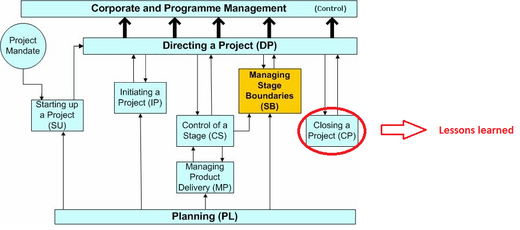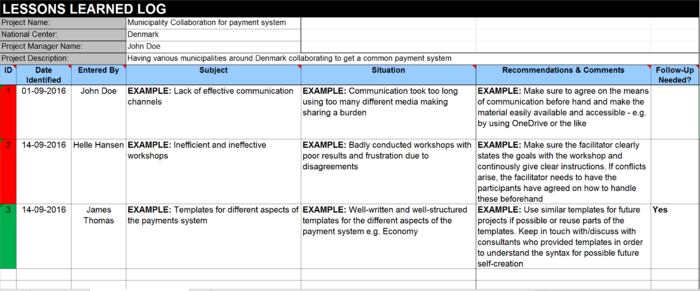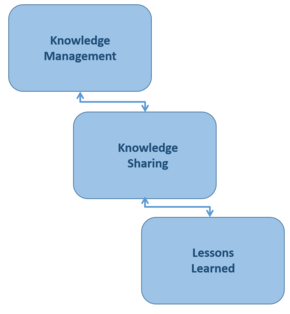Lessons learned - a tool for sharing knowledge in project management
Lessons learned is a cost-effective project management tool that aims to bring together any insight gained during a specific project, which can be usefully applied in future projects. [1].Lessons learned is a mean to learn what went wrong and what went right in a given project and build on this knowledge aquired in order to improve future projects. According to Project Management Institute (PMI), project management is the application of knowledge, skills, tools and techniques to project activities in order to meet project requirements and objectives. [2]. The challenging task of managing projects can somewhat be aided through the usage of the tool, Lessons learned. Project Management Institute (PMI) defines lessons learned as the learning gained from the process of performing the project. [3].
Lessons learned is part of Knowledge Management </ref>, which is defined as[4].:
"managing the corporation's knowledge through a systematically and organizationally specified process for acquiring, organizing, sustaining, applying, sharing and renewing both the tacit and explicit knowledge of employees to enhance organizational performance and create value"
Lessons learned is spawned from the knowledge management process, Knowledge Sharing, as lessons learned indeed is a mean to sharing knowledge. Knowledge sharing covers both explicit knowledge (codified knowledge e.g. found in documents), tacit knowledge (intuitive knowledge and know-how) and embedded knowledge (knowledge locked in processes, products, cultures etc.) and lessons learned can be used to communicate either type of knowledge and is hence not bounded to one type, but will probably tend to focus on explicit and at times embedded knowledge. It is however important that lessons learned covers all types of knowledge obtained within the project in order to make the sharing optimal.[5]
Lessons learned is not a new term in the world of project management, but is however often a neglected one. The downsizing of the usage of lessons learned in projects seem conflicting with the importance of what can be gained from an effective lessons learned. An effective lessons Learned process should prevent the organisation from repeating its mistakes and allow it to repeat its successes. It should be an instrumental part of any organization’s overall continuous improvement” proces. [6]
The article starts out by providing a brief introduction to lessons learned and its role in a project management framework. Further, the application of the tool is presented; firstly by describing the methodology and then as an example application. The article lastly moves on to discussing the benefits and limitations linked to lessons learned.
Contents |
Overview
Introduction
Project management is becoming a more and more integral part of every organisation - spanning different countries, areas and sectors - in order to improve projects. Many organisations base their project management methods on the project management methodology, PRINCE2. PRINCE2 (PRojects In Controlled Environments, version 2) is a framework that provides guidelines that encompasses quality management, control and organisation of a project with consistency and review to align with project objectives. [7].
PRINCE2 is process-driven project management methodology, which builds on seven principles/processes that defines project management:

- Starting up a project (SU)
- Initiating a project (IP)
- Directing a project (DP)
- Controlling a stage (CS)
- Managing product delivery (MD)
- Managing stage boudaries (SB)
- Closing a project (CP)
Projects are parts of organisations everywhere, anytime and occurs in different sizes, durations and complexity levels. Often, a lot of the work is focused on the initiating of the project as well as the execution of the project - however, at least as important is the closing of the project. The closing of a project concludes the project, the project should formally be decommissioned. The key activities of the closing the project is listed below. [9]
- Decomissioning a project
- Identifying follow-on actions
- Preparing af benefits review plan
- Project evaluation
Decomissioning the project basically means that the project needs to be formally closed as in to avoid letting the project going on internally, identifying follow-on actions are actions that needs to be carried on after the completion of the project. Prepapring the benefits review plan is a plan for when the benefits of the project ought to be measured and how and what resources are needed, and finally project evaluation is where the project is evaluated; pros and cons are listed and improvements for future projects can be listed. This can be accomplished by utilising the lessons learned tool. CONTINUE? Something about lessons learned not necessarily only at the closing process - can be performed at all stages in the project.
Application
Methodology
The Lessons Learned is not a fixed method, but rather depends on the temper and environment of the organisation hence the format and syntax may vary from organisation to organisation. However, following the PRINCE2 methodology, a lessons learned template is provided. It should be noted that the template is in no way prescribed and the various organisations are encouraged to develop their own template which includes the necessary fields/themes in order to improve projects specific to that organisation. An example is provided in the article.

| Column | Definitions |
| Project name | <Optional>. Can be filled out for easy access |
| National Center | <Required>. |
| Project manager | <Required>. Full name and/or initials. |
| Project description | <Required>. Short summary of the project. It is advised to add specific conclusions, implementations and results. |
| A | ID: Lessons learned log's idenfication number. The ID number must be unique to the specific lessons learned |
| B | Date identified: The date the lessons learned was identified. |
| C | Entered by: The employee who identified the lessons learned. Can be either full name or initials. |
| D | Subject: A brief attention grabbing headline describing the subject of the lessons learned. |
| E | Situation: A detailed description of the situation learned from. |
| F | Lessons Learned and Recommendations: A detailed description of the lessons learned from the situation. Extends and supports the subject (D) and situation (E) columns. Further describes the corrective actions taken. Includes recommendations in regard to the corrective actions in order to guide future projects. |
| G | Follow-up needed: A description of if follow-up actions are needed. |
Example of Lessons Learned

Lessons learned as part of Knowledge Sharing - STORAGE MAYBE IN THE END?
Knowledge sharing is one of the most important and crucial activities to an organisation’s operation and survival and ought to be a part of the organisation’s projects. [11].Knowledge sharing is a process of knowledge management and is defined as an activity through which knowledge (namely information, skills, or expertise) is exchanged among people, friends, families, communities, or organizations. [12].
CONTINUE - FIGURES SHOWING HIERARCHY CONTENT MANAGEMENT SYSTEMS - DOCUMENT MANAGEMENT SYSTEMS
Benefits
Limitations
Alternative approach
Annotated Bibliography
KNOWLEDGE MANAGEMENT + SHARING
References
- ↑ [https://www.projectsmart.co.uk/lessons-learned.php] Project Smart, Last visited 13-09-2016
- ↑ Project Management Institute. (2008). A Guide to the Project Management Body of Knowledge. 4th Edition. p. 6. USA. ISBN 9781933890517
- ↑ http://www2a.cdc.gov/cdcup/library/pmg/implementation/ll_description.html Project Management Institute, Project Management Body of Knowledge, Last visited 13-09-2016
- ↑ Davenport, T.H., Prusak, L., Successful knowledge management projects Sloan Management Review 39 (2), p. 43-57
- ↑ [http://www.knowledge-management-tools.net/different-types-of-knowledge.html] Types of Knowledge, Knowledge Management Tools, Last visited 14-09-2016
- ↑ Westney Consulting Group 2014 Implementing an Effective Lessons Learned Process in a Global Project Environment. Mark Marlin PMP Sr. Vice President, Article. Available online here
- ↑ https://www.axelos.com/best-practice-solutions/prince2 PRINCE2 Official Website, Last visited 13-09-2016
- ↑ Wikipedia. The PRINCE2 Process Model. Last visited 13-09-2016
- ↑ Pr. https://en.wikipedia.org/wiki/PRINCE2. PRINCE2 Closing principle. Last visited 14-09-2016
- ↑ 10.0 10.1 10.2 XLS-file, choose hit no. 3 The PRINCE2 Template for Lessons Learned. Last visited 14-09-2016
- ↑ Serban, M.A., Luan, J. (2002). Overview of Knowledge Management. New Directions For Institutional Research no. 13, Wiley Periodicals
- ↑ Bukowitz, W.R., Williams, R.L. (1999). The Knowledge Management Fieldbook. FT Press, ISBN 978-0273638827
